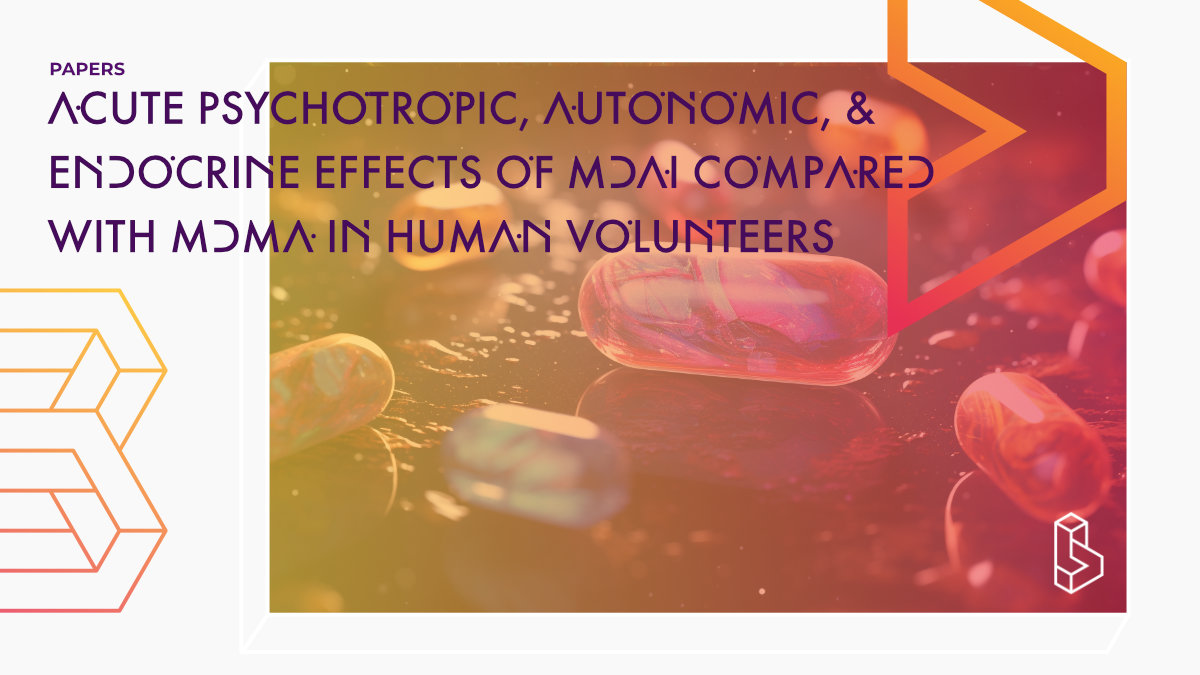This non-blinded study (n=6) investigated the acute psychoactive, autonomic, and endocrine effects of the new psychoactive substance (NPS) 5,6-methylenedioxy-2-aminoindane (MDAI) at a dose of 21mg/40kg. Compared to placebo-controlled studies on MDMA, MDAI was well-tolerated, produced subjective effects similar to 125 mg of MDMA, and increased blood pressure similarly, but did not increase heart rate or body temperature. MDAI also elevated cortisol and prolactin levels, remaining detectable in serum for at least four days.
Abstract of Acute psychotropic, autonomic, and endocrine effects of 5,6-methylenedioxy-2-aminoindane (MDAI) compared with 3,4-methylenedioxymethamphetamine (MDMA) in human volunteers: A self-administration study
“The acute psychoactive, autonomic, and endocrine effects of the new psychoactive substance (NPS) 5,6-methylenedioxy-2-aminoindane (MDAI; 3.0 mg/kg, range 180-228 mg) were investigated in six healthy volunteers (four males, two females) in a non-blinded fashion without placebo. Subjective, cardiovascular, and endocrine responses were compared with two different doses of 3,4-methylenedioxymethamphetamine (MDMA) (75 mg and 125 mg) described in previously published placebo-controlled studies, which used identical outcome measures including Visual Analogue Scales (VAS), the Adjective Mood Rating Scale (AMRS), and the 5 Dimensions of Altered States of Consciousness (5D-ASC) scale. MDAI was well tolerated and produced subjective effects comparable with those of 125 mg MDMA. MDAI increased blood pressure similar to 125 mg MDMA but did not increase heart rate or body temperature. MDAI increased cortisol and prolactin levels and could be detected in serum about 20 min post ingestion and remained detectable at least for 4 days. In urine, MDAI was detectable over a period of at least 6 days. Further clinical investigations are warranted to assess whether MDAI could serve as drug with medicinal properties.”
Authors: Verena Angerer, Yasmin Schmid, Florian Franz, Heike Gnann, Jan Manuel Speer, Anke Gnann, Stephan Helmecke, Armin Buchwald, Simon D Brandt, Torsten Passie, Matthias E Liechti & Volker Auwärter
Summary of Acute psychotropic, autonomic, and endocrine effects of 5,6-methylenedioxy-2-aminoindane (MDAI) compared with 3,4-methylenedioxymethamphetamine (MDMA) in human volunteers: A self-administration study
Introduction
The emergence of new psychoactive substances has attracted the attention of policymakers, regulatory institutions, healthcare providers, and researchers across the globe. A highly dynamic and typically poorly regulated market has evolved around the manufacturing and supply of psychoactive compounds.
A substance called 6,7-dihydro-2H,5H-indeno[5,6-d][1,3]dioxol-6-amine appeared on the NPS market around 2010 and was soon available for purchase from Internet retailers. It was later detected in biological samples obtained from treatment clinics, intoxications, and death cases.
Find this paper
https://doi.org/10.1002/dta.3622
Open Access | Google Scholar | Backup | 🕊
Cite this paper (APA)
Angerer V, Schmid Y, Franz F, Gnann H, Speer JM, Gnann A, Helmecke S, Buchwald A, Brandt SD, Passie T, Liechti ME, Auwärter V. Acute psychotropic, autonomic, and endocrine effects of 5,6-methylenedioxy-2-aminoindane (MDAI) compared with 3,4-methylenedioxymethamphetamine (MDMA) in human volunteers: A self-administration study. Drug Test Anal. 2023 Dec 6. doi: 10.1002/dta.3622. Epub ahead of print. PMID: 38056906.
Study details
Compounds studied
MDMA
Topics studied
Healthy Subjects
Study characteristics
Open-Label
Participants
6
Humans

